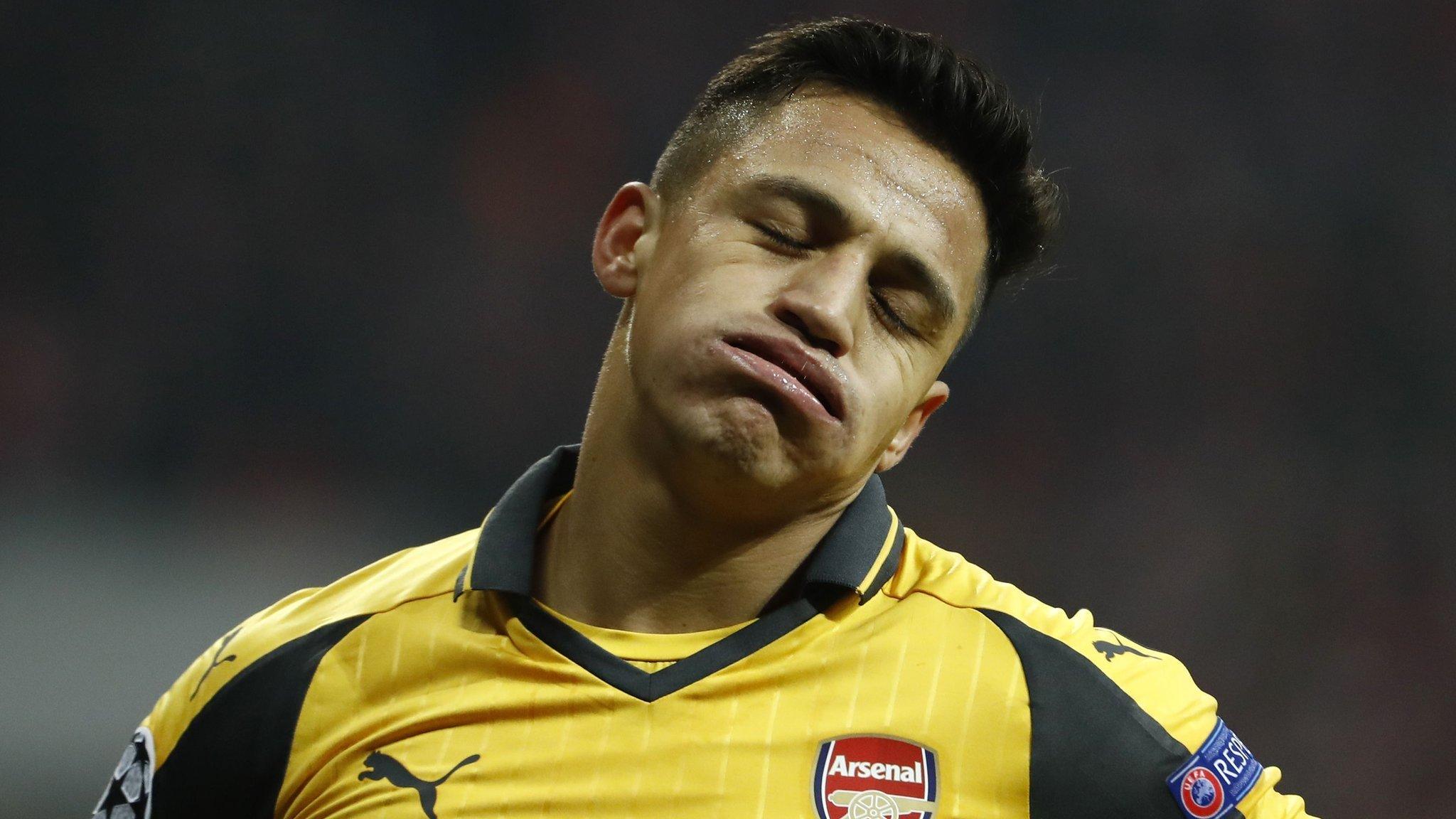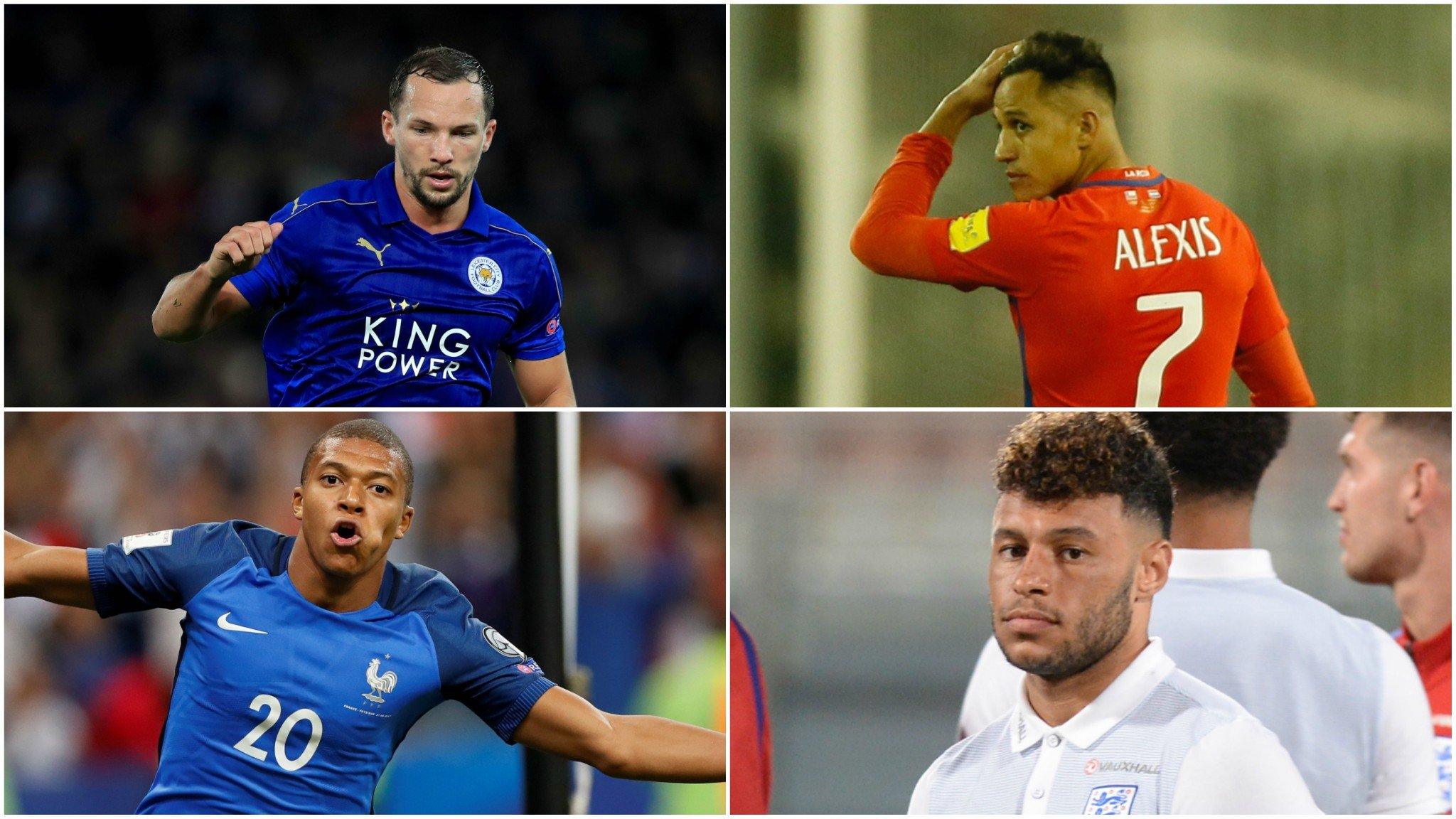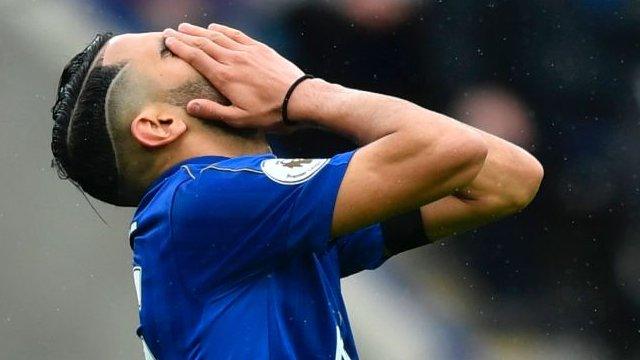Premier League: Who is your team's 'most influential' player?
- Published
- comments

Alexis Sanchez, Philippe Coutinho and Virgil van Dijk will all - in theory at least - be available for their clubs this season after moves failed to materialise
Alexis Sanchez, Philippe Coutinho, Virgil van Dijk, Riyad Mahrez, Gylfi Sigurdsson and Ross Barkley dominated this summer's transfer window.
But were they really worth all that talk?
Would Sanchez's departure have had a major impact on Arsenal's performances? Is Coutinho really Liverpool's star man?
Possibly not, according to a new way of ranking players based on their importance, which claims to tell us who really makes the biggest difference to a team's fortunes.
It enables us to assess who are the most - and least - influential members of Premier League squads.
And there are some surprising results.
What is this system and how does it work?
Ever heard of plus-minus ratings? They've been used in basketball and ice hockey for nearly half a century and are a way of identifying which players are the most valuable to their team.
In those sports it tells you the points advantage/disadvantage a side experience when a particular player is on the pitch.
So, for example, when LeBron James was on the court for Cleveland Cavaliers during the 2016-17 NBA season, they could expect to score, on average, an extra 8.42 points per 100 possessions compared with when he was not in action. He was, therefore, the NBA's most influential player., external
In football it follows the same premise as in the American sports - but in this new model, devised by data experts from the University of Liverpool (Professor Ian McHale), University of Salford (Dr Tarak Kharrat) and University College London (Dr Javier Lopez-Pena), it has been adapted to factor in things such as home advantage, the impact of red cards, strength of team-mates, opposing players and any substitutions that have been made.
It is also based on expected goals, rather than actual goals, as this is considered a more accurate reflection of a team's performance. So, this way, a defender's ranking isn't negatively affected by an attacking team-mate missing an open goal.
All this gives us a player's plus-minus rating which, at its simplest, compares how a team perform with a player to how they perform without them. A plus rating means the team do better with them, a minus rating means the team fare better without them.
There is quite a lot more to it than that - see the bottom of this article for a more in-depth explanation.
What does the rating system tell us?
The results tell us who each team's most important - and least important - players are.
First of all, here are the 10 most influential players last season for current Premier League clubs based on this analysis.
The value assigned to each player is their plus-minus rating per 90 minutes - the number of expected goals the team were better off by when that player was on the pitch.
Most influential players at current Premier League clubs during the 2016-17 season | ||
|---|---|---|
Player | Club | Plus-minus rating |
David Silva | Manchester City | 3.09 |
Sergio Aguero | Manchester City | 2.8 |
Petr Cech | Arsenal | 2.52 |
Raheem Sterling | Manchester City | 2.49 |
Jan Vertonghen | Tottenham | 2.35 |
John Stones | Manchester City | 2.3 |
Hector Bellerin | Arsenal | 2.29 |
Isaac Hayden | Newcastle | 2.22 |
Matt Ritchie | Newcastle | 2.21 |
Aleksandar Kolarov | Manchester City | 2.2 |
Note: Only includes those who played a minimum of 900 minutes in 2016-17. Newcastle's figures relate to when they were in the Championship | ||
And what about the players who were the subject of so much transfer speculation during the summer?
How influential were the summer's most talked about transfer targets? | |||
|---|---|---|---|
Player | Team | Plus-minus rating | Team ranking |
Alexis Sanchez | Arsenal | 1.41 | 7th |
Philippe Coutinho | Liverpool | 1.15 | 5th |
Virgil van Dijk | Southampton | 0.96 | 3rd |
Ross Barkley | Everton | 0.04 | 5th |
Gylfi Sigurdsson | Swansea | -0.78 | 10th |
Riyad Mahrez | Leicester | -0.92 | 10th |
All data relates to 2016-17 season | |||
This analysis tells us Coutinho was less influential than two of the players who have been in Liverpool's attacking line-up instead of the Brazil attacking midfielder so far this season, Sadio Mane and Roberto Firmino. Perhaps Barcelona's £114m offer was targeting the wrong player at Anfield.
Sigurdsson and Mahrez - discussed all summer, though only one changed clubs when Sigurdsson joined Everton for £45m - were only their teams' 10th most important players when it came to having a positive impact on their expected goal difference.
According to these ratings, Van Dijk would have been a significant loss to Southampton - he emerges as their best defender and the team were 0.96 expected goals better off per game when he played.
But Barkley, who turned down a move to Chelsea on deadline day, made little difference for Everton. His 0.04 rating was enough to put him fifth in the Toffees' list of most influential players - but was lower than every member of the Stamford Bridge club's title-winning squad.
And Sanchez, while unquestionably having a positive impact on Arsenal overall, was not as influential in statistical terms as Mesut Ozil. Or Alex Iwobi.
In fact, his 1.41 rating was lower than all of the attacking players at Manchester City, the club who came close to signing him for £60m on deadline day.
How Sanchez compares with Manchester City's attacking players | ||
|---|---|---|
Player | Team | Plus-minus rating |
David Silva | Man City | 3.09 |
Sergio Aguero | Man City | 2.8 |
Raheem Sterling | Man City | 2.49 |
Leroy Sane | Man City | 2.03 |
Kevin de Bruyne | Man City | 1.98 |
Yaya Toure | Man City | 1.56 |
Alexis Sanchez | Arsenal | 1.41 |
All data relates to 2016-17 season and only includes those who played a minimum of 900 minutes | ||
So who were the most - and least - influential players at your club?
The following data relates only to the 2016-17 season.
Who were your clubs's most - and least - influential players in 2016-17? | ||||
|---|---|---|---|---|
Team | Top three players | Plus-minus value per 90 minutes | Bottom three players | Plus-minus value per 90 minutes |
Arsenal | Petr Cech | 2.52 | Theo Walcott | -0.48 |
Hector Bellerin | 2.29 | Alex Oxlade-Chamberlain | -0.04 | |
Mesut Ozil | 2.11 | Aaron Ramsey | 0.28 | |
Bournemouth | Benik Afobe | 0.83 | Marc Pugh | -1 |
Dan Gosling | 0.57 | Junior Stanislas | -0.52 | |
Jordon Ibe | 0.13 | Andrew Surman | -0.51 | |
Brighton | Sam Baldock | 2.14 | Jamie Murphy | -1.76 |
Glenn Murray | 1.21 | Oliver Norwood | -1.5 | |
Solly March | 1 | Tomer Hemed | -0.47 | |
Burnley | Ashley Barnes | 0.77 | Sam Vokes | -1.5 |
Joey Barton | 0.41 | Dean Marney | -1.1 | |
George Boyd | 0.06 | Scott Arfield | -0.98 | |
Chelsea | Victor Moses | 1.77 | Willian | 0.26 |
Diego Costa | 1.74 | Cesc Fabregas | 0.98 | |
Gary Cahill | 1.72 | Pedro | 1.11 | |
Crystal Palace | James Tomkins | 0.52 | Scott Dann | -1.03 |
Luka Milivojevic | 0.32 | Wayne Hennessey | -0.85 | |
Christian Benteke | 0.25 | Martin Kelly | -0.82 | |
Everton | Joel Robles | 0.62 | Maarten Stekelenburg | -1.85 |
Ramiro Funes Mori | 0.44 | Gareth Barry | -1.51 | |
Seamus Coleman | 0.22 | Phil Jagielka | -1.13 | |
Huddersfield | Michael Hefele | 1.37 | Collin Quaner | -0.84 |
Jonathan Hogg | 0.8 | Philip Billing | -0.46 | |
Aaron Mooy | 0.71 | Kasey Palmer | -0.34 | |
Leicester | Jamie Vardy | 0.59 | Danny Drinkwater | -1.41 |
Yohan Benalouane | 0.23 | Kasper Schmeichel | -1.14 | |
Daniel Amartey | 0.2 | Wes Morgan | -1.09 | |
Liverpool | Sadio Mane | 1.51 | Lucas Leiva | -0.76 |
Jordan Henderson | 1.41 | Simon Mignolet | -0.12 | |
Roberto Firmino | 1.34 | Divock Origi | -0.1 | |
Manchester City | David Silva | 3.09 | Jesus Navas | 0.21 |
Sergio Aguero | 2.08 | Pablo Zabaleta | 0.68 | |
Raheem Sterling | 2.49 | Claudio Bravo | 1 | |
Manchester United | David de Gea | 1.97 | Matteo Darmian | -0.37 |
Henrikh Mkhitaryan | 1.44 | Chris Smalling | -0.03 | |
Marcos Rojo | 1.43 | Wayne Rooney | 0.01 | |
Newcastle | Isaac Hayden | Jack Colback | -0.7 | |
Matt Ritchie | 2.21 | Mohamed Diame | -0.55 | |
Ayoze Perez | 1.97 | Daryl Janmaat | -0.12 | |
Southampton | Steven Davis | 1.24 | Dusan Tadic | -0.23 |
Oriol Romeu | 1.03 | Pierre-Emile Hojbjerg | -0.22 | |
Virgil van Dijk | 0.96 | Jack Stephens | -0.14 | |
Stoke | Charlie Adam | 0.85 | Jonathan Walters | -0.75 |
Glen Johnson | 0.77 | Ramadan Sobhi | -0.6 | |
Xherdan Shaqiri | 0.58 | Peter Crouch | -0.29 | |
Swansea | Jordi Amat | -0.26 | Leroy Fer | -0.86 |
Wayne Routledge | -0.36 | Fernando Llorente | -0.74 | |
Federico Fernandez | -0.44 | Jack Cork | -0.66 | |
Tottenham | Jan Vertonghen | 2.35 | Vincent Janssen | 0 |
Eric Dier | 1.72 | Mousa Dembele | 0.45 | |
Dele Alli | 1.62 | Ben Davies | 0.56 | |
Watford | Stefano Okaka | 0.89 | Nordin Amrabat | -0.27 |
Valon Behrami | 0.36 | Odion Ighalo | -0.19 | |
Roberto Pereyra | 0.35 | Abdoulaye Doucoure | -0.17 | |
West Brom | Jonny Evans | 0.21 | Matt Phillips | -0.94 |
Chris Brunt | 0.2 | James McClean | -0.61 | |
Craig Dawson | 0.04 | Claudio Yacob | -0.36 | |
West Ham | Sofiane Feghouli | 0.45 | Winston Reid | -1.3 |
Sam Byram | 0.18 | Mark Noble | -1.15 | |
Aaron Cresswell | 0.06 | Edimilson Fernandes | -0.82 | |
Note: When rating most influential players, we have only included those who played at least 900 minutes (10 games). When assessing the least influential players, we have only included those who missed at least 10 games. This is because the plus-minus system struggles to identify differences between a team WITH a player and that team WITHOUT a player if he has been involved in almost all of the matches. | ||||
While these figures tell us each team's most and least influential players, they also reveal that some had virtually no positive or negative impact on their team's expected goals return.
Tottenham striker Vincent Janssen's score of exactly 0 informs us that his side did not do better when he was on the pitch - but they also did not suffer. He had a totally neutral impact.
The same can be said for Wayne Rooney at Manchester United last season. His rating of 0.01 backs up what many observers felt to be the case - that his previously significant impact on his team was decreasing.
What else can we learn from these ratings?
These ratings can be used as a way to identify players who are performing above average, regardless of the level of their team.
So if a player at a mid-ranking side has an excellent plus-minus rating, it means their influence in generating a positive net expected goals value is strong. It could identify them as someone capable of playing at a higher level.
Take Jonny Evans, for example. This rating system ranks him as West Brom's most influential player in 2016-17 - and he is one of only three people at The Hawthorns with a positive plus-minus rating. Perhaps that helps to explain why Manchester City identified him as a key defensive target this summer.
It can also work the other way. If, over the course of the season, a player has a negative rating, it tells us that the team perform worse than average when that player is on the pitch.
As an example, Theo Walcott has the lowest ranking of any Arsenal player, suggesting they are a more effective side when other attacking combinations are used.
How this system works - in detail
Take the following hypothetical example.
Alexis Sanchez plays 60 minutes in one Arsenal game, being substituted with the Gunners losing 1-0. In the next game, Sanchez comes on with 30 minutes left with the Gunners 3-0 up. He is on the pitch for 30 minutes and they score twice more to win 5-0.
From this we can work out his plus-minus rating.
Arsenal were minus one goal in the 60 minutes (-1/60) he was on the pitch in the first game, but plus two goals in the 30 minutes (+2/30) he played in the second game.
So ((−1/60) + (2/30)) × 90 = +4.5.
In other words, when the player was on the pitch the team scored 4.5 goals per 90 minutes more than the opposition.
But the key thing is how that compares with the team's rating when the player was not on the pitch.
So, in this hypothetical example, there were no goals in the final 30 minutes (0/30) of game one when Sanchez was off the field, while in game two there were three goals in the 60 minutes (3/60) before he came on.
So ((0/30) + (3/60)) × 90 = 4.5.
The rating with the player - the rating without the player = their overall rating.
In this hypothetical instance for Sanchez: 4.5 - 4.5 - 0.
That means he could be said to have a completely neutral impact - they would be neither better nor worse without him.
Are there any problems with this method?
The reason this way of rating players has not previously been used much in football is that goals and substitutions are relatively rare, whereas in basketball lots of points are scored in any given phase of a game and the set of players on the court constantly changes. This makes it easier to determine the impact a player has.
Also, in football, there are lots of factors which might affect whether a team perform better when a particular player comes on.
For example, if Manchester City bring on a striker when they are 3-0 up and the opposition are as good as beaten, his chance of scoring could be considered better than if he had started the game when the other team had something to cling on to.
And what if City were at home, only playing against 10 men and the other side had taken off their best defender to give him a rest as the game was already lost?
This is why the standard plus-minus model has been tweaked to factor in the importance of:
Home advantage
Strength of each opposition player on the pitch
Strength of each team-mate on the pitch
Red cards
Any substitutions that have been made
Of course, this method cannot allow for everything. It cannot measure a player's influence on team morale, for example, other than by assessing how they fare when he is on or off the pitch.
It also cannot measure the effect a player has on a club from a wider perspective - a cult hero or club legend might not actually be that productive on the field any more, but for supporters having that player in the team may be symbolic, above and beyond whether their rating means they no longer merit a place in the starting XI.
Cynics may say a statistical model cannot replace a coach's naked eye or instinct, but it certainly provides food for thought for managers, players and scouts alike.
Follow Match of the Day on Instagram, external for the best photos from the world of football.
- Published8 September 2017

- Published1 September 2017

- Published10 August 2017
